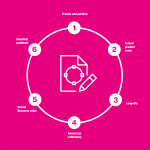Total Quality Management (TQM) is a structured system for satisfying internal and external customers and suppliers by integrating the business environment, continuous improvement, and breakthroughs with development, improvement, and maintenance cycles while changing organizational culture. TQM aims for quality principles to be applied broadly throughout an organization or set of business processes. Total Quality Management (TQM) programs focus on improvement in individual operations with unrelated processes; as a consequence, it takes many years before all operations within a given process are improved. Six Sigma focuses on making improvements in all operations within a process that produce results more rapidly and effectively.
The Six Sigma’s Breakthrough Strategy is a disciplined method of using extremely rigorous data-gathering and statistical analysis to pinpoint sources of errors and ways of eliminating them. Six Sigma relies on the voice of the consumer to set the standard of acceptable performance. Six Sigma has a systematic approach to both validate data and to focus on the critical few inputs that will have the greatest potential to effect meaningful improvement.
Six Sigma focuses on reducing defects in management and clinical process; it uses statistical analysis to find the most defective part of the process, and rigorous control procedures to sustain improvement.
While Six Sigma is a long-term strategy, it is designed to generate immediate improvements to profit margins too. Compared to traditional quality management programs such as TQM that project three or more years into the future, Six Sigma focuses on achieving financial targets in twelve-month increments.
TQM and Six Sigma have a number of similarities including the following:
1. A customer orientation and focus
2. A process view of work
3. A continuous improvement mindset
4. A goal of improving all aspects and functions of the organizations
5. Data based decision-making
6. Benefits depend highly on effective implementation
A key difference between TQM and Six Sigma is that Six Sigma focuses on prioritizing and solving specific problems which are selected based on the strategic priorities of the company and the problems which are causing the most defects whereas TQM employs a more broad based application of quality measures to all of the company’s business processes. Another difference is that TQM tends to apply quality initiatives within specific departments whereas Six Sigma is cross-functional meaning that in penetrates every department, which is involved in a particular business process that is subject to a Six Sigma project.
Another difference TQM provides less methodology in terms of the deployment process whereas Six Sigma’s DMAIC framework provides a stronger platform for deployment and execution. For example, Six Sigma has a much stronger focus on measurement and statistics, which helps the company, define and achieve specific objectives. Six Sigma is complementary to TQM because it can help to prioritize issues within a broader TQM program and provides the DMAIC framework, which can be used to meet TQM objectives.
Conclusion
Both measurements of quality control within an organization have brought true success to companies who have applied their policies and procedures.
The leaders and management teams of any organization will have to evaluate which quality of control tactic is the most beneficial to the growth and improvements of their business.
The one way to analyze your business is to establish your goals and vision for your organization and set plans in place to evaluate if Six Sigma or Total Quality Management falls in the realms of what you are seeking.
Both processes have taken the best of the best countries and companies from good to great and I personally feel that as long as you have one of these processes in place, you are setting yourself up for success.
.

93,559 Comments
cialis medicine in india
Hello there, You have done an incredible job. I will certainly digg
it and personally suggest to my friends. I’m confident they’ll be benefited from this web site.
You actually make it seem really easy with your presentation but I find this matter to
be really something which I feel I’d never understand.
It seems too complex and very broad for me. I am looking ahead on your subsequent put up, I’ll attempt
to get the hold of it!
This is a topic that is close to my heart… Cheers! Exactly where are your contact details though?
My web page – Vibrant 3D Print Round-Neck Tee (http://www.ebay.co.uk)
I know this if off topic but I’m looking into starting my
own blog and was wondering what all is needed to get setup?
I’m assuming having a blog like yours would cost a pretty
penny? I’m not very web smart so I’m not 100% positive.
Any suggestions or advice would be greatly appreciated.
Thank you
how to buy valtrex without a prescription
This is very interesting, You are a very skilled blogger.
I have joined your rss feed and look forward to seeking more of your wonderful
post. Also, I’ve shared your site in my social networks!
Here is my webpage – Comfortable Hooded Street Fashion (http://www.ebay.co.uk)
I believe everything published was actually very logical.
But, what about this? what if you were to create a awesome headline?
I ain’t suggesting your information is not solid,
however what if you added a title that grabbed folk’s attention? I
mean EVALUATING TOTAL QUALITY MANAGEMENT V/S SIX SIGMA – Thomas Gachie is a little boring.
You could peek at Yahoo’s home page and note how
they create post headlines to grab viewers interested.
You might add a video or a pic or two to get readers interested about everything’ve
written. In my opinion, it could make your website a little livelier.
Feel free to visit my homepage :: Graphic Print Shirt S-6XL Fashion